OCT Balanced Detectors with Fast Monitor Output
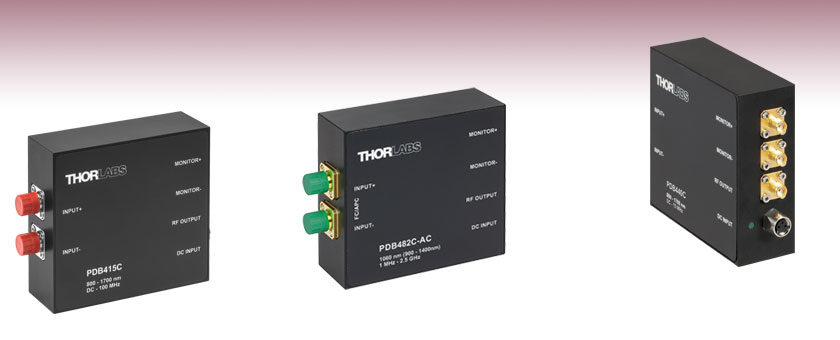
- Models Available with Bandwidths up to 2.5 GHz
- Wavelengths Covering the 320 to 1700 nm Range
- >20 dB Common Mode Rejection Ratio
- Fast Monitor Outputs
PDB415C
Fixed Gain, 100 MHz, Si
Optical Inputs Shown
PDB482C-AC
Fixed Gain, 2.5 GHz, InGaAs, AC Coupled
Optical Inputs Shown
PDB440C
Fixed Gain, 15 MHz, InGaAs
Electrical Outputs Shown

Please Wait
| Balanced Detector Selection Guide |
|---|
| Balanced Detectors with Fast Monitor Output |
| Large-Area Balanced Amplified Detectors |
| Suitable for OCT |
| Compact Balanced Amplified Detectors |
| Compact 5 GHz Balanced Detectors |
| OCT Balanced Detectors with Fast Monitor Output |
| Auto-Balanced Detector with Avalanche Photodiodes |
| Polarization-Dependent Balanced Detector |
| OCT Balanced Detectors with Fast Monitor Output | ||
|---|---|---|
| Wavelength | Bandwidths Available | Fast Monitor Output Bandwidth |
| 320 - 1000 nm | DC - 15 MHz DC - 75 MHz DC - 100 MHz DC - 200 MHz |
DC - 1 MHz |
| 800 - 1700 nm | ||
| Optimized for 1060 nm (900 - 1400 nm Range) |
DC - 400 MHz 30 kHz - 1.0 GHz |
DC - 3 MHz |
| 1 MHz - 2.5 GHz | DC - 2.5 MHz | |
| Optimized for 1300 nm (1200 - 1700 nm Range) |
DC - 400 MHz 30 kHz - 1.6 GHz |
DC - 3 MHz |
Features
- Bandwidths up to 2.5 GHz Available
- Four Wavelength Options
- 320 - 1000 nm
- 800 - 1700 nm
- 900 - 1400 nm (Optimized for 1060 nm)
- 1200 - 1700 nm (Optimized for 1300 nm)
- >20 dB Common Mode Rejection Ratio
- All Versions Available with FC Fiber Inputs
- Free Space Inputs on Some Detectors (See Below for Details)
- Switchable Power Supply Included
These balanced amplified photodetectors are designed specifically for OCT applications. They act as a balanced receiver by subtracting the two optical input signals from each other, resulting in the cancellation of common mode noise. This allows small changes in the signal path to be extracted from the interfering noise floor.
The detectors consist of two balanced photodiodes and an ultra-low-noise, high-speed transimpedance amplifier. The two photodiodes are matched to achieve an excellent common mode rejection ratio (CMRR), leading to better noise reduction. Please see the Operation tab for more details. All of these detectors incorporate three female SMA electrical ports for reduced noise. In addition to the RF-output from the transimpedance amplifier, the Monitor+ and Monitor- ports allow the response of each photodiode to be observed individually.
Bandwidths of DC - 200 MHz or Lower
Detectors with bandwidths of DC - 200 MHz or lower are available with either Si photodiodes for the 320 - 1000 nm range or InGaAs photodiodes for the 800 - 1700 nm range. Choose from four bandwidths: DC - 15 MHz, DC - 75 MHz, DC - 100 MHz, or DC - 200 MHz. The inputs on these detectors are not fiber coupled to the photodiodes. Detectors with bandwidths of DC - 100 MHz or lower come with two removable FC input connectors, making them suitable for either free space or fiber applications. The DC - 200 MHz bandwidth detectors also have FC/PC connectors at the inputs, but they cannot be removed.
Bandwidths of DC - 400 MHz or Higher
Detectors with bandwidths of DC - 400 MHz or higher feature fiber-coupled InGaAs photodiodes connected to FC/APC optical inputs with exactly length-matched SMF-28e+ or HI1060 fiber to achieve excellent CMRR values across the full detector bandwidth. The fiber-coupled design suppresses line artifacts in the OCT image, which generally occur when detector coupling optics are used. The combination of fiber and photodiodes was chosen to optimize these detectors for either 1060 nm (900 - 1400 nm range) or 1300 nm (1200 - 1700 nm range).
Our highest bandwidth detectors are offered in an AC-coupled version only. The PDB480C-AC, PDB481C-AC, and PDB482C-AC balanced detectors offer bandwidths up to 2.5 GHz, leading to considerable speed improvements. The ultra-low-distortion output stage supports up to a 2 Vp-p A/D card input range, which, combined with the fiber-coupled design, improves the image quality for OCT applications considerably.
Packaging/Power Supply
Housed in a shielded aluminum enclosure measuring 85 mm x 80 mm x 30 mm, these detectors are post mountable using the included adapter plate, which can be attached to the bottom or side of the housing with the included M2 screws. A ±12 V linear power supply that supports input voltages of 100, 120, and 230 VAC is included with each amplified photodetector. Replacement power supplies are available separately below.
A complete list of all of Thorlabs' balanced amplified photodetectors with fast monitor output can be found here. Alternatively, we also offer an APD-based auto-balanced detector with an exceptionally low noise floor suitable for OCT applications with low signal in the sample arm. Thorlabs also offers Fiber-Based Interferometers, which feature an integrated balanced detector.
| Item # | PDB415A | PDB415C | PDB425A | PDB425C | PDB440A | PDB440C | PDB465A | PDB465C |
|---|---|---|---|---|---|---|---|---|
| Detector Type | Si/PIN | InGaAs/PIN | Si/PIN | InGaAs/PIN | Si/PIN | InGaAs/PIN | Si/PIN | InGaAs/PIN |
| Wavelength Range | 320 - 1000 nm | 800 - 1700 nm | 320 - 1000 nm | 800 - 1700 nm | 320 - 1000 nm | 800 - 1700 nm | 320 - 1000 nm | 800 - 1700 nm |
| Typical Max Responsivity | 0.53 A/W | 1.0 A/W | 0.53 A/W | 1.0 A/W | 0.53 A/W | 1.0 A/W | 0.50 A/W | 1.0 A/W |
| Active Detector Diameter | 0.8 mm | 0.3 mm | 0.8 mm | 0.3 mm | 0.8 mm | 0.3 mm | 0.8 mm | 0.15 mm |
| Bandwidth (3 dB) | DC - 100 MHz | DC - 75 MHz | DC - 15 MHz | DC - 200 MHz | ||||
| Common Mode Rejection Ratio |
>25 dB | >35 dB | >35 dB | <25 dB | ||||
| Transimpedance Gaina | 50 x 103 V/A | 250 x 103 V/A | 51 x 103 V/A | 30 x 103 V/A | ||||
| Minimum NEPb | 12.03 pW/Hz1/2 (DC - 100 MHz) |
6.99 pW/Hz1/2 (DC - 100 MHz) |
9.5 pW/Hz1/2 (DC - 75 MHz) |
5.2 pW/Hz1/2 (DC - 75 MHz) |
6.9 pW/Hz1/2 (DC - 15 MHz) |
3.9 pW/Hz1/2 (DC - 15 MHz) |
22.86 pW/Hz1/2 (DC - 200 MHz) |
8.52 pW/Hz1/2 (DC - 200 MHz) |
| RF Output | ||||||||
| RF Output Conversion Gaina,c | 26.5 x 103 V/W | 50 x 103 V/W | 133 x 103 V/W | 250 x 103 V/W | 27 x 103 V/W | 51 x 103 V/W | 16 x 103 V/W | 30 x 103 V/W |
| CW Saturation Power | 135 µW @ 820 nm |
72 µW @ 1550 nm |
27 µW @ 820 nm |
15 µW @ 1550 nm |
130 µW @ 820 nm |
70 µW @ 1550 nm |
225 µW @ 820 nm | 120 µW @ 1550 nm |
| Impedance | 50 Ω | |||||||
| Max Voltage Swing | ±1.8 V for 50 Ω Load ±3.6 V for High-Impedance Load |
|||||||
| DC Offset | < ±3 mV | |||||||
| RF-Output Coupling | DCd | |||||||
| Monitor Outputs | ||||||||
| Monitor Output Conversion Gain | 10 V/mW @ 820 nm |
10 V/mW @ 1550 nm |
10 V/mW @ 820 nm |
10 V/mW @ 1550 nm |
10 V/mW @ 820 nm |
10 V/mW @ 1550 nm |
10 V/mW @ 820 nm |
10 V/mW @ 1550 nm |
| Impedance | 220 Ω | |||||||
| Max Voltage Swing | 1.55 V for 50 Ω Load 10 V for High-Impedance Load |
|||||||
| Bandwidth | DC to 1 MHz | |||||||
| Voltage Noise | <180 µVRMS | |||||||
| DC Offset | < ±2 mV | |||||||
| General | ||||||||
| Fiber Optical Inputse | FC/PC or FC/APC (Removable) |
FC/PC or FC/APC (Not Removable) |
FC/PC or FC/APC (Removable) |
FC/PC or FC/APC (Not Removable) |
||||
| Photodiode Damage Threshold | 20 mW | |||||||
| Electrical Outputs | SMA (Qty. 3) | |||||||
| Dimensions | 85 mm x 80 mm x 30 mm (3.35" x 3.15" x 1.18") | |||||||
| Weight | 0.35 kg (without Power Supply) | |||||||
| Operating Temperature Rangef | 0 to 40 °C |
|||||||
| Storage Temperature Range | -40 to 70 °C | |||||||
| Included Power Supplyg | ±12 V @ 200 mA 115/230 VAC, 50 - 60 Hz, Switchable |
|||||||
| Item # | PDB470Ca | PDB471Ca | PDB480C-ACa | PDB481C-ACa | PDB482C-ACa |
|---|---|---|---|---|---|
| Detector | |||||
| Detector Type | InGaAs/PIN | ||||
| Optical Inputs | FC/APC | ||||
| Internal Coupling Fiber | SMF-28e+ | HI1060 | SMF-28e+ | HI1060 | |
| Coupling Loss | <0.5 dB (<0.3 dB Typ.) | <1.0 dB (<0.4 dB Typ.) | <0.5 dB (<0.3 dB Typ.) | <1.0 dB (<0.4 dB Typ.) | |
| Operating Wavelength | Optimized for 1300 nm (1200 - 1700 nm Range) |
Optimized for 1060 nm (900 - 1400 nm Range) |
Optimized for 1300 nm (1200 - 1700 nm Range) |
Optimized for 1060 nm (900 - 1400 nm Range) |
|
| Responsivity (Typical) | 0.9 A/W @ 1300 nm | 0.72 A/W @ 1060 nm | 0.9 A/W @ 1300 nm | 0.72 A/W @ 1060 nm | |
| Active Detector Diameter | 0.075 mm | 0.080 mm | 0.075 mm | 0.080 mm | |
| Optical Back Reflection | <-40 dB | ||||
| Photodiode Damage Threshold | 10 mW | 5 mW | 10 mW | 5 mW | |
| RF OUTPUT | |||||
| RF OUTPUT Bandwidth (3 dB) | DC - 400 MHz | 30 kHz - 1.6 GHz | 30 kHz - 1.0 GHz | 1 MHz - 2.5 GHz | |
| Common Mode Rejection Ratio | >25 dB (Typ. >30 dB) | >20 dB (Typ. >25 dB) | |||
| RF OUTPUT Transimedance Gain | 10 x 103 V/Ab | 16 x 103 V/Ac | 28 x 103 V/Ac | ||
| RF OUTPUT Conversion Gain | 9 x 103 V/W @ 1300 nmb |
7.2 x 103 V/W @ 1060 nmb |
14.4 x 103 V/W @ 1300 nmc |
11.5 x 103 V/W @ 1060 nmc |
20 x 103 V/W @ 1060 nmc |
| RF OUTPUT Power at 1 dB Compressionc | - | +16.5 dBm Min +18 dBm Typ. |
|||
| RF OUTPUT CW Saturation Power | 420 µW @ 1300 nm | 530 µW @ 1060 nm | See Note Below | ||
| RF OUTPUT Coupling | DC (AC Coupling Available upon Request) | AC Coupling Only | |||
| RF OUTPUT Impedance | 50 Ω | ||||
| Max Voltage Swing | ±1.9 V for 50 Ω Load ±3.8 V for High-Impedance Load |
See Note Below | |||
| Minimum NEPd | 8 pW/Hz1/2 (DC to 100 MHz) |
9.3 pW/Hz1/2 (30 kHz to 100 MHz) |
9.0 pW/Hz1/2 (30 kHz to 100 MHz) |
12.0 pW/Hz1/2 (1 MHz to 100 MHz) |
|
| Overal Output Voltage Noise | <2.0 mVRMS | <9 mVRMS | <6.5 mVRMS | <12 mVRMS | |
| MONITOR Outputs | |||||
| MONITOR Output Impedance | 200 Ω | ||||
| MONITOR Output Bandwidth (3 dB) | DC - 3 MHz | DC - 2.5 MHz | |||
| MONITOR Output Conversion Gain, High Z Loadb | 9 V/mW @ 1300 nm | 7.2 V/mW @ 1060 nm | 9 V/mW @ 1300 nm | 7.2 V/mW @ 1060 nm | |
| MONITOR Output Voltage Swing, High Z Load | 10 V Max | ||||
| Overall Output Voltage Noise | <0.65 mVRMS | ||||
| DC Offset | < ±2 mV | ||||
| General | |||||
| Electrical Outputs | SMA | ||||
| Included DC Power Supplye | ±12 V @ 250 mA 100/120/230 VAC, 50 - 60 Hz, Switchable |
||||
| Operating Temperature Rangef | 0 °C to 40 °C | ||||
| Storage Temperature Range | -40 °C to 70 °C | ||||
| Dimensions (W x H x D) | 85 mm x 80 mm x 30 mm (3.35" x 3.15" x 1.18") | ||||
| Weight | 0.35 kg | ||||
Note:
For the PDB480C-AC, PDB481C-AC, and PDB482C-AC detectors the RF output signal must not exceed the RF Output Power at 1 dB Compression, which is the point at which the amplified signal at 1 GHz is compressed by 1 dB. Above this value, the amplified signal will become non-linear and begin to saturate. The RF output voltage at this saturation point can be calculated using the following formula:
![]()
where R is the load impedance (50 Ω), P0 is defined as 1 mW, and L(dBm) is the power level in dBm. Using the specified RF Output Power at 1 dB Compression of 16.5 dBm, this yields the following "maximum" output voltage:

Operation of Balanced Detectors with Bandwidths up to 400 MHz
Thorlabs' Balanced Amplified Photodetectors consist of two well-matched photodiodes and an ultra-low noise, high-speed transimpedance amplifier (TIA) that generates an output voltage (RF OUTPUT) proportional to the difference between the photocurrents in the two photodiodes (i.e., the two optical input signals). Additionally, the unit has two fast monitor outputs (MONITOR+ and MONITOR-) to observe the optical input power levels on each photodiode separately. These outputs are low frequency outputs and cannot be used to measure an RF modulation on the signal. The block diagram applies to our balanced detectors with bandwidths up to 400 MHz.

Operation of the PDB480C-AC, PDB481C-AC, and PDB482C-AC Balanced Detectors
The PDB48xC-AC Balanced Amplified Photodetectors use the same basic operating principles as described above and have the following additional features. The TIA's ultra-low distortion output stage supports up to a 2 Vp-p A/D card input range. The two fast monitor outputs can be used to measure not only the individual optical input power levels, but also low frequency modulated signals up to 3 MHz (Item #s PDB480C-AC and PDB481C-AC) or 2.5 MHz (Item # PDB482C-AC). To enable the much higher frequency of these detectors, the photodiodes are connected to the inputs with length-matched fibers, only AC-coupled versions are offered, and capacitors are added to the circuit (as shown below).

Pin Diagrams for OCT Balanced Detectors
Monitor +/-
SMA Female

Maximum Voltage is +10 V for Hi-Z & +1.5 V into 50 Ω loads.
RF Output
SMA Female

For the PDB415, PDB425, PDB440, and PDB465 photodetectors, the maximum RF OUTPUT voltage is ±3.6 V for Hi-Z & ±1.8 V into 50 Ω loads.
The RF OUTPUT CW saturation power is 420 µW @ 1300 nm and 530 µW at 1060 nm for the PDB470C and PDB471C, respectively.
For the PDB48xC-AC photodetectors, the RF OUTPUT Power at 1 dB compression into 50 Ω loads is +16.5 dBm (Min), +18 dBm (Typical)
PDB Male (Power Cables)

PDB Female (Photodetector)

| Posted Comments: | |
sebastian.marschall
(posted 2013-09-23 13:17:20.217) Hello
What is the reason for the different frequency responses of the PDB480C-AC (1.6 GHz) and the PDB481C-AC (1.0 GHz).
Would there be big problems when using the PDB480C-AC with 1060 nm light (coupling losses, mode-dispersion, etc.)?
Regards, Sebastian tschalk
(posted 2013-09-26 06:29:00.0) This is a response from Thomas at Thorlabs. Thank you very much for your inquiry. The bandwidth of the respective detector is defined by the pigtailed diodes built in. Those are designed for a specific wavelength, both because of the fiber used as pigtail as well as for the diode itself. The diode used in the PDB481-AC can unfortunately operate in a stable regime only up to 1GHz. While it would be in principle be possible to use the PDB480C-AC at 1060nm, the diode being not optimized for this wavelength would induce higher losses. The modal dispersion in this case should be negligible considering the short length of the pigtails. I will contact you directly with more detailed information. |

| Specificationsa | ||||||
|---|---|---|---|---|---|---|
| Item # | PDB440A | PDB425A | PDB415A | PDB465A | ||
| Wavelength Range | 320 - 1000 nm | |||||
| Detector Type | Si/Pin | |||||
| Typical Max Responsivity | 0.53 A/W | 0.50 A/W | ||||
| Active Detector Diameter | 0.8 mm | |||||
| Bandwidth (3 dB) | DC - 15 MHz | DC - 75 MHz | DC - 100 MHz | DC - 200 MHz | ||
| Common Mode Rejection Ratio |
>35 dB | >25 dB | ||||
| Transimpedance Gainb | 51 x 103 V/A | 250 x 103 V/A | 50 x 103 V/A | 30 x 103 V/A | ||
| Optical Inputs | FC/PC or FC/APC (Removable) |
|||||
| Monitor Output Bandwidth |
DC - 1 MHz | |||||

| Specificationsa | ||||
|---|---|---|---|---|
| Item # | PDB440C | PDB425C | PDB415C | PDB465C |
| Wavelength Range | 800 - 1700 nm | |||
| Detector Type | InGaAs/PIN | |||
| Typical Max Responsivity | 1.0 A/W | |||
| Active Detector Diameter | 0.3 mm | 0.15 mm | ||
| Bandwidth (3 dB) | DC - 15 MHz | DC - 75 MHz | DC - 100 MHz | DC - 200 MHz |
| Common Mode Rejection Ratio |
>35 dB | >25 dB | ||
| Transimpedance Gainb | 51 x 103 V/A | 250 x 103 V/A | 50 x 103 V/A | 30 x 103 V/A |
| Optical Inputs | FC/PC or FC/APC (Removable) |
FC/PC or FC/APC (Not Removable) |
||
| Monitor Output Bandwidth |
DC - 1 MHz | |||

| Specificationsa | |||
|---|---|---|---|
| Item # | PDB471C | PDB481C-AC | PDB482C-AC |
| Operating Wavelength | Optimized for 1060 nm (900 - 1400 nm Range) |
||
| Detector Type | InGaAs/PIN | ||
| Internal Coupling Fiber | HI1060 | ||
| Responsivity (Typical) | 0.72 A/W @ 1060 nm | ||
| Active Detector Diameter | 0.080 mm | ||
| Bandwidth (3 dB) | DC - 400 MHz | 30 kHz - 1.0 GHz | 1 MHz - 2.5 GHz |
| Common Mode Rejection Ratio | >25 dB (Typ. >30 dB) |
>20 dB (Typ. >25 dB) |
|
| Transimpedance Gain | 10 x 103 V/Ab | 16 x 103 V/Ac | 28 x 103 V/Ac |
| Optical Inputs | FC/APC | ||
| Monitor Output Bandwidth | DC - 3 MHz | DC - 2.5 MHz | |

Click to Enlarge
The blue shaded region indicates the specified wavelength range for these balanced detectors. 1060 nm is marked with a vertical blue line.

| Specificationsa | ||||
|---|---|---|---|---|
| Item # | PDB470C | PDB480C-AC | ||
| Operating Wavelength | Optimized for 1300 nm (1200 - 1700 nm Range) |
|||
| Detector Type | InGaAs/PIN | |||
| Internal Coupling Fiber | SMF-28e+ | |||
| Responsivity (Typical) | 0.9 A/W @ 1300 nm | |||
| Active Detector Diameter | 0.075 mm | |||
| Bandwidth (3 dB) | DC - 400 MHz | 30 kHz - 1.6 GHz | ||
| Common Mode Rejection Ratio | >25 dB (Typ. >30 dB) |
|||
| Transimpedance Gain | 10 x 103 V/Ab | 16 x 103 V/Ac | ||
| Optical Inputs | FC/APC | |||
| Monitor Output Bandwidth | DC - 3 MHz | |||

Click to Enlarge
The blue shaded region indicates the specified wavelength range for these balanced detectors. 1300 nm is marked with a vertical blue line.


- Replacement Power Supply for the Balanced Amplified Photodetectors Sold Above
- ±12 VDC Power Output
- Current Limit Enabling Short Circuit and Overload Protection
- On/Off Switch with LED Indicator
- Switchable AC Input Voltage (100, 120, or 230 VAC)
- 2 m (6.6 ft) Cable with LUMBERG RSMV3 Male Connector
- UL and CE Compliant
The LDS12B ±12 VDC Regulated Linear Power Supply is intended as a replacement for the supply included with our PDB line of balanced photodetectors sold on this page. The cord has three pins: one for ground, one for +12 V, and one for -12 V (see diagram above). This power supply ships with a location-specific power cord. This power supply can also be used with the PDA series of amplified photodetectors, PMM series of photomultiplier modules, APD series of avalanche photodetectors, and the FSAC autocorrelator for femtosecond lasers.
 Products Home
Products Home










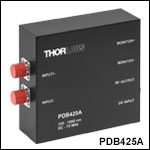
 Zoom
Zoom


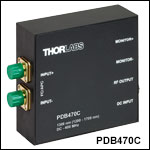
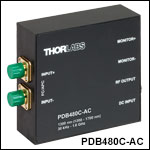
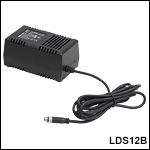
 OCT Balanced Detectors with Fast Monitor Outputs
OCT Balanced Detectors with Fast Monitor Outputs